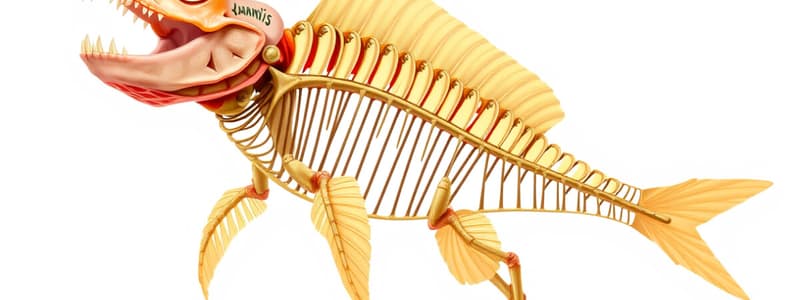Podcast
Questions and Answers
What are the three types of muscles found in Chordates?
What are the three types of muscles found in Chordates?
Striped, unstriped, and cardiac muscles.
What is the significance of a well-developed coelom in Chordates?
What is the significance of a well-developed coelom in Chordates?
It allows for the development of complex organ systems and provides a space for organ function.
Explain the term 'unisexual' in the context of Chordates.
Explain the term 'unisexual' in the context of Chordates.
Unisexual refers to organisms that have distinct male and female sexes.
List the seven classes of Subphylum Vertebrata.
List the seven classes of Subphylum Vertebrata.
Describe the lifecycle of a lamprey.
Describe the lifecycle of a lamprey.
What characterizes the body structure of a sea squirt?
What characterizes the body structure of a sea squirt?
How many chambers does the heart of certain Chordates have?
How many chambers does the heart of certain Chordates have?
What role do endocrine glands play in Chordates?
What role do endocrine glands play in Chordates?
What are the key features of the alimentary canal in Chordates?
What are the key features of the alimentary canal in Chordates?
How do respiratory and excretory systems in Chordates compare?
How do respiratory and excretory systems in Chordates compare?
Flashcards are hidden until you start studying
Study Notes
Phylum Chordata Overview
- Belongs to Kingdom Animalia, includes all vertebrates (animals with backbones) and some invertebrates.
- Characterized by a bilaterally symmetrical body and divided into three subphyla.
Key Characteristics of Phylum Chordata
-
Notochord
- Longitudinal, cartilaginous rod located between the nerve cord and digestive tract.
- Provides support for the nerve cord and is replaced by the vertebral column in vertebrates post-embryonic stage.
-
Dorsal Nerve Cord
- A bundle of nerves running along the back; splinters into the brain and spinal cord.
- Hollow structure positioned dorsal to the notochord.
-
Pharyngeal Slits
- Openings that allow water entry without access to the digestive system, linking mouth and throat.
- Present in all chordates at some life stage.
-
Post-Anal Tail
- Extension of the body beyond the anus, aiding locomotion in fish-like species.
- Typically absent in most adult chordates.
-
Additional characteristics include:
- Bilaterally symmetrical, triploblastic, coelomic, and segmented body.
- Complex, well-differentiated body design with organ system organization.
Classification of Phylum Chordata
- Classified into three subphyla:
-
Urochordata (Tunicates)
- Marine invertebrates with a body enclosed in a cellulose-like tunic.
- Notochord present only in larval stage; adult forms are fixed to the substratum.
- Examples: Ascidia, Salpa, Doliolum.
-
Cephalochordata (Lancelets)
- Possess both notochord and dorsal nerve cord throughout their life.
- Exhibit well-developed pharyngeal gill slits and motile forms during adult and larval stages.
-
Vertebrata (Vertebrates)
- Advanced chordates with a cranium surrounding the brain.
- Notochord replaced by a vertebral column in adulthood.
- Display high cephalization, multi-layered epidermis, and advanced organ systems.
-
Characteristics of Vertebrates
- Well-developed coelom and complete alimentary canal.
- Heart can be three or four-chambered; complex respiratory and excretory systems.
- Presence of endocrine glands.
- Typically unisexual with sexual reproduction; hagfish being an exception.
Subclass Classification of Vertebrata
- Further classified into seven classes:
- Cyclostomata
- Chondrichthyes
- Osteichthyes
- Amphibia
- Reptilia
- Aves
- Mammalia
Examples of Phylum Chordata
-
Lampreys
- A jawless fish belonging to subphylum Vertebrata; filter-feeder in larval stage.
- Transforms into a parasitic adult.
-
Sea Squirt
- Urochordate with a barrel-shaped body attached to the substratum.
- Tadpole-like larva possesses notochord, dorsal nerve, pharyngeal slits, and post-anal tail.
Studying That Suits You
Use AI to generate personalized quizzes and flashcards to suit your learning preferences.




